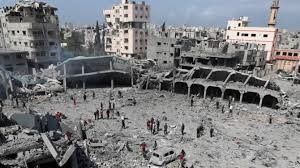Prato: Chinese workers transform Italy’s fast fashion hub

Milan: Cobbled streets, fountains, and Romanesque churches — walking through Prato’s historic center feels like stepping into a romanticized version of old Europe.
But just beyond the city walls, in neighborhoods like Via Pistoiese and Via Fabio Filzi, the landscape shifts. Red lanterns hang above supermarkets stocked with Chinese goods, signs advertise food and snacks, and the air hums with Mandarin and regional dialects.
“It felt disorienting, like stepping into a third- or fourth-tier Chinese county town from the 1990s or 2000s,” recalls Zheng Ningyuan, a Chinese documentary artist who first visited Prato a decade ago.
Prato is home to both luxury brands like Prada and mass-market fast fashion firms. Since the late 1980s, large numbers of Chinese immigrants have sustained the “Made in Italy” label.
By 2021, more than 27,000 Chinese residents lived in Prato — about 15% of the city’s population, one of the highest concentrations in Europe.
By offering cheap labor and high-speed production, they transformed Prato’s traditional craft-based model of garment production. The new and successful “Chinese model” in turn continued to attract more Chinese immigrants.
“At that time, Europe seemed like paradise,” recalls Li Qiu (name changed), from Zhejiang, China, who came to Italy in 2007. Her relatives had already come at the end of the last century to work in textiles. She said that in those years, everyone around her was “making big money in euros and bringing it back.”
She also came to Prato to work as a textile worker and pursue her “Italian dream.” After seven or eight years, she saved enough money to open a Chinese restaurant in town, which she has operated until now. “But now things are different. Regulations are tighter, and business is much harder,” she said.
Chinese immigrants gave Prato a new face but also stirred controversy. Critics say they displaced Italian jobs and turned Prato into a “Chinatown.” Others question whether garments produced with Chinese fabrics and labor truly merit the “Made in Italy” label.
According to EU and Italian regulations, to qualify as “Made in Italy,” products must follow the “principle of last substantial transformation,” meaning the final major processing must take place in Italy, creating a new product with distinct characteristics before it can be labeled “Made in Italy.”
But legal interpretation leaves gray areas, and enforcement is difficult. Although some garments in Prato use imported raw materials or semi-finished products from China, since the final key processing — such as cutting and sewing — takes place in Italy, they can still be labeled “Made in Italy.”
For Zheng, the issue goes beyond legality: “Defining quality by whether Chinese made it risks a racist narrative. Many aim for high-quality production. But the cost of Prato’s cheap goods is borne by immigrants.”
The garment industry’s reputation is tainted by labor abuses. In 2013, a fire in a Chinese-run factory killed seven workers. Although the Italian government strengthened control over Chinese-run factories afterward, problems have remained serious for the past decade.
According to Politico, residence permits in Italy are often tied to employment contracts. Many immigrants, in order to stay in Italy, are forced to accept part-time or informal work, leaving them open to exploitation. Conditions for undocumented workers may be even worse.
Recently, the local union Sudd Cobas, which called for strikes, claimed that some textile workers in Prato work up to 84 hours a week but may earn only €800 ($926) per month. Many seek union protection but remain vulnerable. Pakistani and other migrant laborers face similar conditions.
Organized crime has also moved in, with assaults and arson striking Chinese-run factories in recent months. Police report gangs battling over the hanger and garment transport market worth €100 million. In April, alleged gang member Zhang Dayong, who had extensive business in Prato, was shot dead in Rome in a case linked to the so-called “hanger wars.”
Li Qiu, who runs a Chinese restaurant, said that when she first came from Zhejiang she could not speak a word of Italian. Decades later, business in Prato has become increasingly difficult, but she has no plans to return to China — not only because “competition is too fierce,” but also because her children have already taken root in Italy.
Since 2019, Zheng, the documentary artist, has conducted field research in Prato.
He noted that many Chinese families there face a challenging situation: if their children grow up in an Italian-speaking environment, they may be unable to communicate with parents because they cannot speak Chinese; if they grow up in China and then move to Prato, they may speak Chinese well but struggle to integrate because they don’t speak Italian.
“Integration should be two-way,” says Zheng. “Italy was not an immigrant country before the 1990s. It still lacks the policies and cultural space to include immigrants.”
The immigration wave has profoundly changed Prato, while migrants themselves — and China — are also evolving.
“Every time I go back to China, it feels more distant. After not returning for a few years, it no longer feels like home,” Zheng says.
“Many people feel they are Chinese, but sometimes they also feel more like Italians. They’ll say, ‘I identify as Chinese, but I may live my whole life in Italy. If I went back, I might not get used to it anymore.'”





